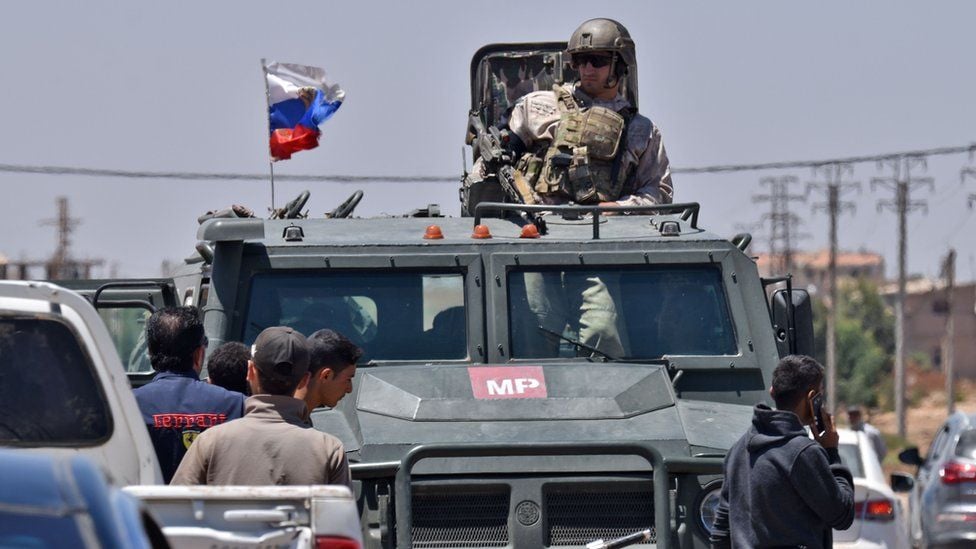Sohaib Boushi, Nader Abosaleh.
In 2018, local notables from southern Syria concluded a reconciliation agreement between the opposition factions from that region and the Syrian regime, under a Russian tutelage. Syrian Association for Citizens Dignity has analysed the failure of this reconciliation agreement in a paper published last year. Since the publication of the paper, the arrests, assassinations and forced recruitment of youth to fight in the Idlib and Aleppo countryside frontlines increased. The Syrian regime reverted to its usual practice of ignoring agreements or laws it issue and began with a series of breaches of what was pledged in the agreement. In early March 2020, the regime forces attempted to forcefully regain control over the Al-Sanamayn area and launched a major military operation to impose its authority over parts of the city of Al-Sanamayn that were still under the control of opposition fighters. Eventually, an agreement was signed to raise the regime’s flag in the city and allow the entry of its police officers in exchange for the return of some services to the city, including electricity and operating of the bread ovens.
It would later transpire that the initial attack was a message that the Syrian regime would not accept any remaining areas in the region to be seen as outside its full control. Despite the agreement, Al-Sanamayn was attacked with the intention of fully regaining control over it and removing the remaining local fighters. This operation provoked reactions throughout the Daraa governorate. The people mobilized against the regime’s actions and demonstrations were launched rejecting the breach of the agreement and the return of control of the regime’s security and military forces to the city of Al-Sanamayn. The regime continued with its attempts to storm the city. In the ensuing clashes, the former opposition fighters killed a number of the regime soldiers and took prisoners. Ultimately, a truce was agreed, the opposition fighters who refused to live under the rule of the regime’s security forces were deported to areas controlled by the opposition forces in northern Syria, and the regime would subsequently restore its full control over the city of Sanamayn.
The prevailing atmosphere in the region after the Al-Sanamayn events indicated a possibility of an all-out conflict between the local former fighters affiliated with the opposition and the regime forces. The tensions were extremely high and the whole region of southern Syria – especially the Daraa Governorate – was on the edge.
Things got worse after the regime adopted a policy of assassinating former members of the opposition known to reject its rule. The killings added to a tinderbox of discontent caused by the constant breaches of the reconciliation agreement, the failure of the Russian guarantors to ensure that the regime fulfils its end of the agreement or to release detainees, the failure to return to work employees dismissed from service due to their opposition to the Assad regime, and the irregularity of services in those areas. In response to the assassinations of their leaders, the former revolutionaries started carrying out counter-assassinations, attacking checkpoints in the area. Daraa was heading back to an all-out war.
The regime, according to one of the its officials, “does not accept the survival of areas outside its control for the terrorists to exploit.” The regime attaches the label of a “terrorist” to all its opponents, and in the case of Daraa it branded as such all the people who continued to protest during the past months in several areas of the western countryside of Daraa, in the towns of Al-Ajami, Tal Shehab, Al-Yadouda, Al-Muzayrib, Zizoun, and the town of Tafas. The people who came out in these demonstrations demanded the release of detainees and called for the departure of Iranian and Hezbollah militias from the governorate. Increasingly, the slogans and graffiti against the regime spread in several cities and towns covered by the reconciliation agreement, reminiscent of the slogans which appeared at the start of the Syrian revolution.
Russian threats in Tafas
During the first month of this year, the regime repeated the scenario from Al-Sanamayn and sought to impose its full military and security control over the city of Tafas. Those who rejected the settlement agreement were ordered to leave to the opposition-controlled areas in northern Syria. In January, negotiations took place between the Russians and the Syrian regime on one side and the Central Reconciliation Committee in Daraa on the other. According to a source from the Syrian Association for Citizen Dignity “the atmosphere of the meeting was replete with threats and intimidation from the Russians, which is remarkable because the Russians were the guarantors of the reconciliation agreement. Now they became a source of the threat, threatening serious consequences if the regime’s demands were not implemented. The regime delivered new demands to the Central Committee, claiming that the Tafas area is full of ISIS elements. The Russians threatened at the meeting to use airplanes and to bomb the city to “eliminate the terrorists present” if the people and the Committee did not yield to the demands. This included the displacement of wanted persons with their families to northern Syria, an increase in the number of members of the Fourth Division to be deployed in the western countryside of Daraa, and the handing over of the medium weapons in the hands of the people of Daraa to the Russians. Major General Ali Mahmoud, one of Maher al-Assad’s associates, told the Central Committee that they brought specialized personnel and cars to loot the town of Tafas if their demands were not.” If the Central Committee was to fulfil the demands, the general claimed that the regime would open a civil registry center, reopen the police station, and incorporate the main hospital into the Ministry of Health. Journalist Jawad al-Abdullah from Tafas told Al-Monitor: “Those who clashed with the regime forces were former revolutionaries from several factions that were previously active in Daraa before the 2018 settlement. The regime is threatening to wage a fierce war, and the Russian side hinted at resorting to the Russian air force. This is a major shift in the Russian position, which was the sponsor of the settlement agreement in 2018.[1]”
This meeting did not come out of nowhere. Almost two weeks earlier, the Russians held a meeting with the Daraa Central Committee and the dignitaries of Daraa in the municipal sports hall. The goal of the meeting was to calm the charged atmosphere in the city and to discuss the release of the detainees in order to calm the city. However, the people’s representatives were stunned by the threats issued by a Russian officer with the rank of Major General who stated explicitly that the “main goal now is that the re-election of Bashar al-Assad to proceed calmly without problems or disturbances.” Central Committee members responded furiously, rejecting to discuss elections while Syria is still insecure, while the Syrian regime is still practicing violence and arbitrary detention of Syrians, while countless detainees have not been released. This was a prequel to subsequent threats and violence that was to come, which saw fierce clashes with tens of casualties[2].
Silent displacement to the north and beyond
The deteriorating conditions have led to the continuation of silent displacement from Daraa governorate to the north of Syria, additionally driven by the continuing arrests of people who have concluded settlement agreements with the regime, their prosecution and the forcible recruitment of youth who were regularly shipped to the worst battlefronts in the north.
A local resident from the western countryside of Daraa commented: “Such demonstrations represent a message to the negotiating parties, especially the Russian side, to abide by the pledges made to the people of the southern regions to preserve the stability of the region, end the security tension and prevent the violations by the Syrian regime forces.” Instead, the policies of the Russian “guarantors” and the Syrian regime led to a new military escalation in the region characterized by liquidations, mutual assassinations and violent conflict on almost daily basis. The collective punishment depriving the people of the main services exacerbated the already difficult situation of the people in Daraa, worsening their poverty and destitution, while at the same time, the regime’s continuous attempts to exploit the reconciliation agreement to penetrate into the villages and forcibly recruit more young people dramatically increased the people’s sense of insecurity. Liquidation of the former opposition leaders, as well as arrests and torture of others, led the vast majority of people in Daraa to believe that the agreement is worthless and led many to leave in what is termed “the second wave of silent displacement” from Daraa.
A.A., a young man who fled Daraa to reach the opposition-held areas in the North says: “The conditions are very bad, and the regime is unable to manage or provide any services in the areas it controlled under the reconciliation agreements. The systematic killing of revolutionary leaders who reject the settlement agreements, and everyone who was previously involved in any activities against the Syrian regime, prompted many young people to flee to opposition-controlled areas in the north. Everyone who has money to pay the smugglers will not hesitate for a moment to escape. Every young man in Daraa is now planning to escape to the opposition-held areas or to Europe, and many people have had to sell their lands in order to secure the cost of smuggling their children. On the journey I was on we were about 100 people walking between minefields, through the mountains to reach the opposition areas. It is a very dangerous road, and the risk of arrest, kidnapping or killing is great, but taking these risks is much easier than staying in Daraa. Most of the smugglers are members of the regime’s intelligence services who have formed their own smuggling networks that deliver fugitives from the regime’s authority to opposition areas in exchange for large sums of money”.
It is no longer a secret that some of the former opposition leaders in Daraa, who agreed to a settlement, had fled to the opposition-held areas after the start of the systematic liquidation operations by the Syrian regime. The last of such leaders was Ramzi Mahmoud Abu Zaid, who was killed after he entered a minefield north of Aleppo while he was trying flee to opposition-held areas with around 100 others who ended up being detained, killed or disappeared.
Safe environment according to Russia
Despite the terrible failure of the reconciliation agreements guaranteed by Russia, the violence that plagued Daraa during the past two years and the continued displacement of people from these areas, the Russians and the Syrian regime are still painting the Syrians a pink dream, that salvation is through reconciliation agreements. The regime’s media machine works to portray the reconciliations as a brilliant success for Russia’s policy in Syria. The last such mirage was presented at the refugee conference held in Damascus on November 11, 2020, which was boycotted by the European Union, the United States, the UK and most other countries involved in discussions on Syria. The Russians tried to promote at the conference that the situation in Syria has improved to the point where it can be considered that a safe environment has been achieved and that the time has come for the return of refugees and the start of the reconstruction process. This illustrates very well how Russia sees the concept of a safe environment: the restoration of the Syrian regime’s control by any means possible. This was most clearly evident in the meeting between the Central Reconciliation Committee in Tafas with representatives of the Syrian regime, sponsored by the Russian officers, in which threats were issued to bomb the city, displace its people and plunder the city as it plundered other cities in Syria.
Reconciliation agreements were pitched as contributing to achieving a safe environment that would help the return of refugees to their homes and lands, and improve their economic situation with the cessation of military operations and an end to arrests and liquidations. But the reality prevailing in areas like Daraa clearly shows otherwise. Statistics prepared by the Martyrs Documentation Office in Daraa show that between 2019 and 2020, the regime killed 483 people, of whom 111 were former opposition fighters who signed settlements with the regime under the guarantees of the Russian forces. Regime forces arrested 1,142 citizens, including 30 women, nine children and some 500 former fighters who signed settlements with the regime. Regime forces also assassinated 42 leaders of the factions that joined the settlement agreements. These assassinations were carried out either by shootings, detonating explosive devices under their vehicles or field executions after kidnappings, with 34 other assassination attempts were also documented.
This systematic policy carried out by the regime and its allies in the Iranian militias and the Lebanese Hezbollah, contribute to the rise in instability which pushes the inhabitants of these cities and villages to displacement. Also, regional tensions between the people of Daraa governorate and the people of As-Suwayda province have resurfaced again, after the clashes that took place between the Fifth Corps in Daraa Governorate (supported by Russia) and the Civil Defense Forces (Shabiha) in the As-Suwayda governorate. The commander of the Fifth Corps, Ahmed al-Awda, Hezbollah, Iran and the Syrian regime are accused by the local people of igniting discord and pushing the people of the region to fight, in order for the Iranian and Hezbollah factions to regain control of the region. While the Russians have previously prevented Hezbollah and the Iranians from interfering in the region and arming one side against another, their grip over the situation seems to be slipping. Crucially, it did not protect the individuals affiliated with the reconciliation agreement from being targeted or killed, making the value of the settlement non-existent.
The deteriorating security situation in Daraa is the safe environment as defined by Russia. In that “safe environment” Syrians still suffer from murder, kidnapping, arrest, displacement and death while trying to flee. Daraa is only a microcosm of what the reality for all of Syria would be if Russia was to “guarantee” safe environment for millions of displaced Syrians. One can only imagine the reality of Daraa imposed on the 13 million displaced persons and refugees if they were forced to live under the authority of Assad. The Syrian regime’s policy of revenge and killing against anyone who has ever dared to demand freedom and dignity would result in hundreds of thousands more dead and disappeared. Daraa is a tragic reminder that there can be no sustainable, safe and dignified return with the Syrian regime in place, and a warning that such return will be only be possible under robust international guarantees which would prevent Russia from imposing its own vision of “safe environment”.
*Cover photo: The Russian military negotiated the ceasefire with opposition commanders in Syria’s Daraa 2018 (AFP)



